[ad_1]
One of the bright spots of the fall season – aside from Halloween! – is the pumpkin patches, filled with their beautiful bounty.
But while you may be imagining lush patches filled with bright orange fruits in the prime of health, it takes some work to get them there. And pumpkins can have their fair share of problems.
Are your pumpkin plants wilting?
Many things can cause this common complaint, including watering issues, and various types of pests and diseases as well.
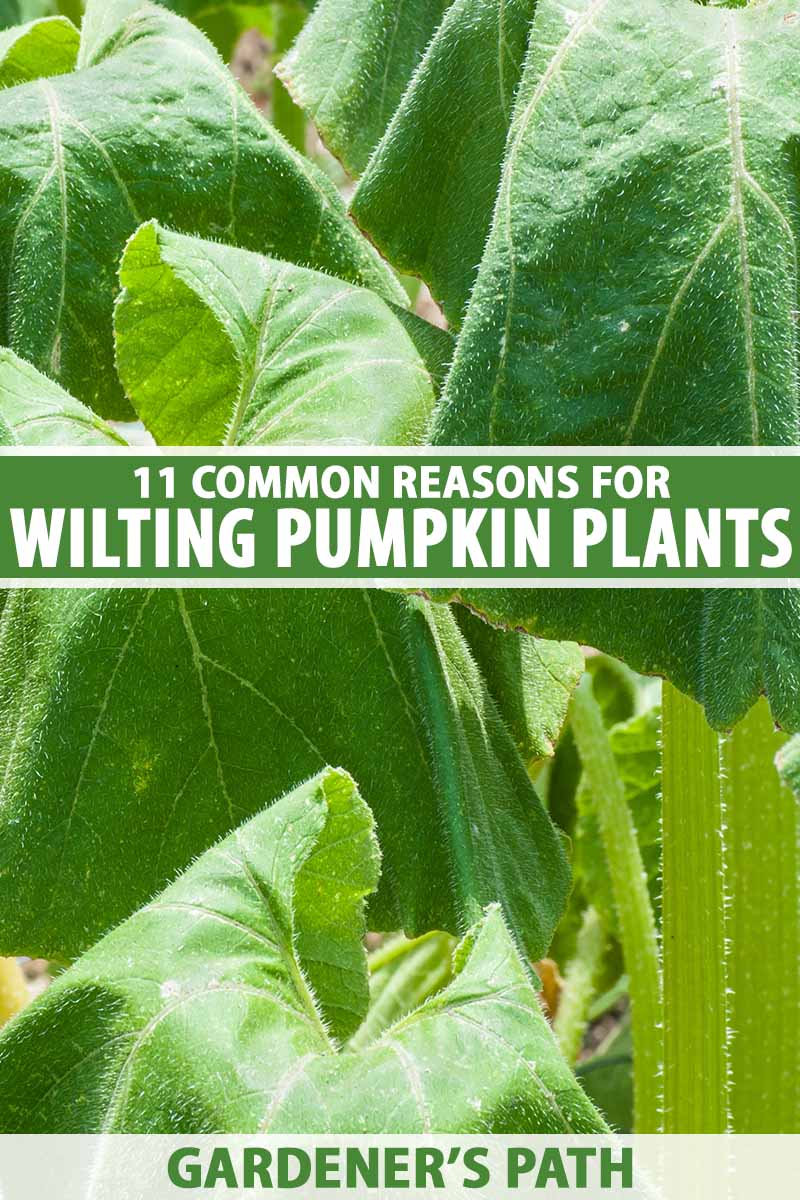

We link to vendors to help you find relevant products. If you buy from one of our links, we may earn a commission.
We will discuss these common causes, and what to do if your pumpkin plants are wilting.
Here’s everything we’ll cover:
11 Common Causes for Wilting Pumpkin Plants
Irrigation Issues
Sometimes it seems like there is just no pleasing certain plants.
If the soil is too dry, your pumpkin plants may wilt. And if the soil is too moist, they may wilt in that case as well.
What’s a gardener to do?
Your best bet is to follow the advice in our guide to growing pumpkins and make sure you provide one to one and a half inches of water per week, including rainfall.
Not sure if they’re getting too much or too little? Let’s take a closer look.
1. Too Little Water
Probably the most common problem on this list, failing to provide enough water can lead to wilting. Fortunately, it’s also the easiest issue to solve.
Pumpkins love to sprawl, and those big vines can guzzle up a lot of liquid in the heat of the summer!
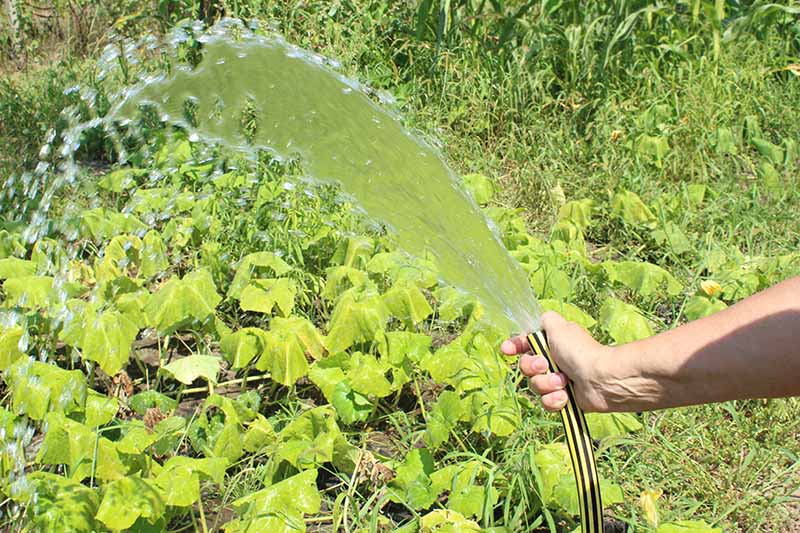

If your plants are wilting due to dry soil, as long as they are healthy otherwise, this can easily be remedied if you catch it in time.
Pumpkins have shallow roots, and you don’t want to disturb them. Check the soil near your plants with your finger or a moisture meter to see if it is dry about an inch down.
If it is, a deep watering should perk them up again. Come back and check again the next day.
During periods of hot, dry weather, they may need supplemental water daily. Be sure to apply it at the soil level, and avoid sprinkling the leaves, fruit, and vines.
If the plants haven’t perked back up in a day or so, another issue may be at play.
2. Too Much Water
Pumpkin plants may also wilt if the soil is too moist. Waterlogged soil can result in fatal root rots. No longer able to take up water, the vines lose color and die.
The soil can accumulate too much moisture from the obvious – heavy precipitation or over-irrigation – or from a lack of adequate drainage.
In the worst cases, both may be contributing to the poor health of your plants.
You can plant your pumpkins in mounds to prevent flooding, incorporating compost or sand into the soil to improve drainage before you sow the seeds, and watering only as needed.
To check for rot, you can carefully dig up your plant and examine the roots. If they are brown or black and slimy, disease has taken hold.
Consider transplanting your waterlogged vines to a more suitable location like a raised bed with excellent drainage as a triage measure.
They may not survive the move, but with any luck, you’ll be able to improve their growing situation adequately and they will return to good health.
Otherwise, dispose of them, and try again next year.
Diseases and Pests
A number of microbes that cause plants to wilt may also affect pumpkins. Pests can also cause damage that leads to wilting, or they may serve as vectors for disease.
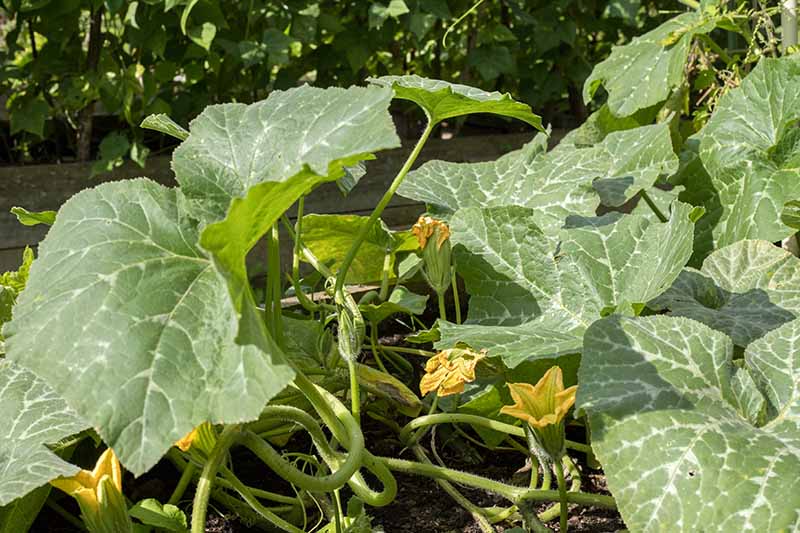

Unfortunately, in many cases your plants will already be too far gone once you notice that they are wilting due to infection, though there are a few steps you can take to try to mitigate the damage that we’ll go over below, depending on the cause.
To protect the health of your plants, prevention is key.
You may not be able to save a pumpkin that’s already started to wilt this year, but you can use that knowledge to garden smarter in the following season, using integrated pest management (IPM) techniques and best practices for care.
Be sure to keep notes in your gardening journal that you can return to next season!
Fungi and Water Molds
One way to control these diseases is to avoid growing any type of cucurbit – including pumpkins, cucumbers, squash, zucchini, gourds, and cantaloupes – again in the same area of the garden for at least three to four years.
Providing adequate spacing to allow for proper airflow, and watering only at the soil level rather than sprinkling the foliage, fruit, and vines, can help to prevent fungal diseases.
An overly moist environment, on the other hand, with crowded beds that leave little breathing room and where plants are not able to dry off quickly after rain, can serve as the perfect breeding ground for disease pathogens that like this type of environment, such as fungi and water molds.
Keeping the garden free of weeds and plant debris, both during and after the growing season, can also help to prevent the spread of these diseases.
Always be sure to clean and sanitize your tools before working in the garden, and moving from one plant to another. And don’t forget that gardening shoes can spread disease pathogens too!
3. Fusarium Crown Rot
More common in melons and cucumbers, Fusarium solani f. sp. cucurbitae is a fungus that may attack pumpkins as well. It can infect the crown, roots, and even the fruit.
Fusarium crown rot travels down from the crown into the roots, and wilting is a common symptom. Additional symptoms are similar to those caused by Phytophthora crown rot, so it is important to know what to look for.
Leaves will turn yellow before browning at the tips, followed by a complete collapse of the plants. Infected stems may be discolored, either yellowish or orange.
If you cut open an infected stem at the crown, it may be pink or brownish inside.
Stressed and fruiting plants are the most susceptible to severe infections. And unfortunately, Fusarium fungal spores can survive in the soil indefinitely.
Infections may be scattered throughout the garden, and since Fusarium crown rot is difficult to control, prevention is highly important.
A key factor is being careful not to move contaminated soil or tools from areas of the garden where this pathogen is a problem into new spaces where the infection may spread.
Biofungicides like RootShield and CEASE can also help to control soilborne pathogens like Fusarium.
4. Phytophthora Crown Rot
Yet another pernicious pathogen of pumpkins is the water mold Phytophthora capsici. The type of crown rot that it causes is a classic problem in wet soils.
Professor emeritus Richard Latin and plant disease diagnostician Karen Rane of Purdue University consider this disorder to be “one of the most serious threats to pumpkin production in Midwestern states.”
It has caused severe crop losses in the Northeast as well.
This pathogen may infect many different types of vegetables as well, including tomatoes and most varieties of peppers.
Phytophthora can survive in the soil indefinitely, and as described by assistant professor and extension specialist Zachariah Hansen, graduate assistant Timothy Siegenthaler, and student assistant Andrew Swafford in the department of entomology and plant pathology at the University of Tennessee Institute of Agriculture Extension, it is “nearly impossible to remove” once it has become established.
This pathogen can spread quickly within and among fields or home gardens. And all types of pumpkins are susceptible to this rot.
You may first notice a problem when you find cottony white mold on the surface of the fruit. Wilting will soon follow, then the vine will eventually collapse and die.
When the culprit is Phytophthora, the rot travels up from the crown into the vines, and the roots may go unscathed. The infected tissue is dark in color, both inside and out.
Plants infected by Phytophthora are usually found in areas where drainage is poor.
Certain fungicides are an option for treatment if you apply them in the early stages of the disease.
Fosetyl-aluminum is a classic treatment for water molds.
You can buy Monterey Agri-Fos Disease Control Fungicide, a product containing this chemical, from Amazon.
Be sure to spray the whole plant as soon as you see symptoms, as a control measure. You can repeat as needed, but making more than six applications per season isn’t recommended.
As with many other pumpkin diseases, crop rotation for four years or more is important after the disease has been noted.
And not just any crop rotation – you will also need to avoid growing snap beans and solanaceous crops like tomatoes, eggplant, and peppers in the area, as well as other cucurbits.
Growing in raised beds or containers filled with new soil each year is another option.
Though rare, if you happen to use pond water to irrigate, stop right away!
Infested irrigation water is a common source of this disease among commercial growers, and your plants can be affected at home as well if you aren’t providing supplementary irrigation from a well or municipal source that is pathogen-free.
Do not transport soil that may be carrying the pathogen to other areas of the garden, to prevent further spread.
If Phytophthora has been a problem in your garden in the past, you can treat the soil preventively with the biofungicides described in the Fusarium crown rot section above at planting time.
Read more about Fusarium and Phytophthora crown rot here.
5. Pythium Root Rot
If you have been gardening for long enough, you have probably dealt with this water mold before, possibly without even realizing it. Pythium species are a common cause of damping off.
These pathogens, known as oomycetes, may cause what’s sometimes referred to as “sudden wilt” in pumpkin plants.
They favor wet conditions, and infections are common in plants grown in heavy soil like clay that retains water.
Infecting plants at the roots, previously healthy-looking leaves will suddenly wilt and turn yellow or white, and sometimes brown around the edges.
This disease progresses rapidly. By the time you notice that your plants are wilting, it’s already too late to save them. They will quickly collapse and die.
Fruit on the vine may be infected as well, affecting the rinds particularly if they are sitting on bare, moist soil. This results in unsightly rotting and scarring, or fluffy white growths.
Pythium root rot is highly contagious, so if you have pumpkin plants that fall victim to this disease, quickly remove them from the garden and dispose of them to prevent further spread.
Be on the lookout next year – if you catch a problem with overly wet conditions early on, you may be able to take steps to mitigate them.
6. Verticillium Wilt
Verticillium wilt is a fungal disease that is common in pumpkins, but it can be difficult to diagnose.
Caused primarily by Verticillium dahliae and V. albo-atrum, it may afflict hundreds of species of plants when the weather is warm and dry, attacking the roots.
Lower leaves wilt and start to turn yellow. Then they dry up, turn brown, and die.
You may note symptoms on just one side of your plant, which can help to distinguish this issue from the normal aging process.
Unfortunately, this disease is generally fatal. Proper fertilizing and watering to maintain the health of plants as best you can may help to extend their life, so you can still achieve a harvest.
Read our article on how and when to fertilize pumpkin plants for tips.
The fungi can live in decaying tissue in the soil for up to 10 years. This means a single infected plant can wreak havoc in the garden, so do your best to purge any that are infected, and dispose of them properly.
Bacteria
Both of the most common bacterial diseases related to wilt that affect pumpkins are associated with insect vectors.
Monitoring your garden regularly for signs of pest infestation, using floating row covers to keep insects out, and even planting trap crops to draw them away from your pumpkin patch may serve as effective means of controlling for bacterial disease.
7. Bacterial Wilt
You might not recognize the name Erwinia, but you may already be familiar with the effects of these pathogens. Several species can cause devastating soft rot infections in potatoes and other vegetables.
Caused by Erwinia tracheiphila in pumpkins, the bacteria spread throughout the xylem – the tubes that carry water upward in the plant. And they produce slime that interferes with the movement of water by gumming up the xylem.
Without the ability to take up water, plants will wilt.
At first, they may just wilt in the heat of the day and then recover later on. But as the disease spreads, often over the course of just a few days, the whole plant will wilt and then die.
Cut an infected stem open and slowly pull it apart. If you see whitish, slimy, mucus-like strands that are connected to the two pieces of the stem, that means the wilting is likely caused by E. tracheiphila.
However, according to Dr. Erika Saalau Rojas, lead author of an extensive study on bacterial wilt, this technique doesn’t always work.
You should try it, though, in case it provides a clear answer for you!
More definitively, beetles are almost undoubtedly a factor.
On its own, E. tracheiphila would not be a problem for your pumpkins. The bacteria does not have the ability to spread by its own means.
These bacteria are not transmitted in seed, and cannot survive in soil. They only live in plant debris for a short time.
So, how do they spread? Their secret to success is in their intimate relationship with cucumber beetles, which we’ll cover in more detail below.
In addition to being transmitted to plants when the beetles feed, the bacteria overwinter in the digestive tracts of these pests as well, enabling future spread if the bugs are not eradicated.
But pesticides will not help if your pumpkin is already suffering from bacterial wilt and showing symptoms.
The best thing to do is to remove infected plants from your garden as quickly as possible and dispose of them properly, to prevent the disease from spreading.
To prevent bacterial wilt disease from occurring in your plants in the first place, your best option is to control the cucumber beetles if you spot them.
8. Yellow Vine Disease
This disease causes pumpkin plants and other cucurbits to turn yellow, wilt, and then die. Leaf margins curl inwards, and larger leaves may turn brown or appear scorched at the margins, though the fruit will typically look just fine.
You can tell if your vines are suffering from this disease by cutting one of the affected stems crosswise. Typically, the cross section will be bright yellow inside, with a brown circle around the outside.
Once believed to be caused by a virus, pink-colored bacteria called Serratia marcescens are actually the culprits.
This is yet another disease that would not be a problem were it not for pests – squash bugs, in this case. Both damage caused by the pests themselves as well as the disease they carry can cause your plants to wilt.
Symptoms of yellow vine disease usually reveal themselves late in the season, just prior to harvest. But infected plants may sometimes wilt and collapse suddenly in the middle of the season as well, or just after fruit set.
There is no effective form of control for this bacterial disease, so control efforts should focus on the squash bugs instead.
Harvest your pumpkins early, so they don’t die on the vine, and dispose of the vines, leaves, and roots in the trash.
Insect Pests
Insect pests, what a bother! While some cause wilting directly, others may spread diseases that make pumpkin leaves droop.
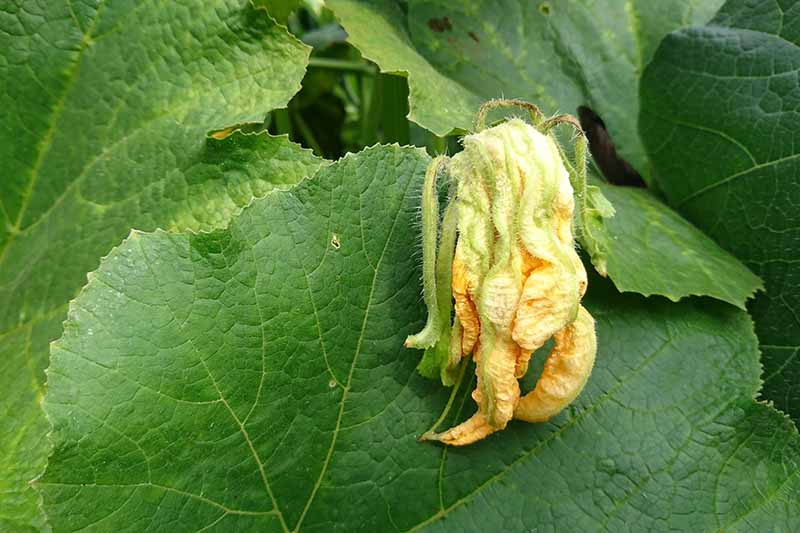

They crave the juicy succulence of homegrown plants as much as we do, though they may sometimes delight in the taste or benefit from the nutrition of different parts than the ones we prefer, and pumpkins are no exception.
When dealing with pests, it’s important to keep beneficial insects in mind as well. Be sure to positively identify the creepy-crawlies that you think may be causing a problem, and address them appropriately and with care.
Pumpkins rely on pollinators to produce those tasty orange orbs, and being overzealous with chemical pest control methods – or even floating row covers – can be a disservice to your plants if the flowers are not pollinated.
9. Cucumber Beetles
Several species of cucumber beetles may harbor and spread this fatal pathogen: striped (Acalymma vittatum), Western striped (A. trivittatum), and spotted (Diabrotica undecimpunctata).
These insects are small, about a quarter of an inch in length, and they feature black and yellow stripes or spots on their backs.
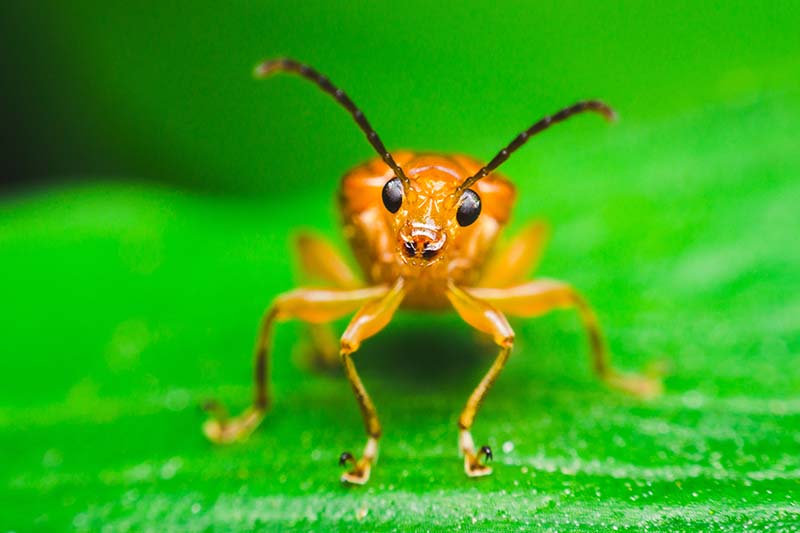

The hungry beetles emerge from the ground in the spring with one mission: to feast on your plants.
Pumpkin leaves are typically toxic to insects, thanks to the cucurbitacins they contain. However, these toxins do not affect striped cucumber beetles.
The spotted variety may sometimes visit your pumpkins as well, though experts claim they do not typically appear in large enough numbers to justify control.
When they feed, the cucumber beetles make wounds that serve as entryways for the disease pathogens that lurk in their mouths or frass. And they can transmit bacterial wilt or cucumber mosaic virus to plants.
Larvae feed on roots while the adults may feed on young shoots, flowers, and leaves, as well as fruit.
Though the damage that results from feeding does not cause plants to wilt, the spread of Erwinia tracheiphila bacteria certainly will.
As a preventive measure to ward off the spread of disease, be sure to keep the garden free of weeds, which may serve as hosts to these insects through the winter, and apply mulch around your plants to prevent the pests from laying eggs.
Rotate your crops from year to year, and remove debris and leaf litter at the end of the season, so the beetles will have fewer sites available to overwinter.
Start looking for cucumber beetles when your pumpkin plants are young, and continue with regular checks until they have started producing fruit. Fortunately, thanks to their contrasting colors, the adults are easy to spot!
Floating row covers can also help to prevent an infestation and later infection. Leave them on until your pumpkins have started blooming.
10. Squash Bugs
These sap-sucking insects, Anasa tristis, use their piercing-sucking mouthparts to extract the sap from leaves, causing yellow discoloration that eventually turns brown. And severe infestations can cause wilting.
A vector for yellow vine disease, these common pests are dark gray to brown or black in color, and about five-eighths of an inch long. They look quite a bit like stink bugs, at least from afar, with flat, shield-shaped backs.
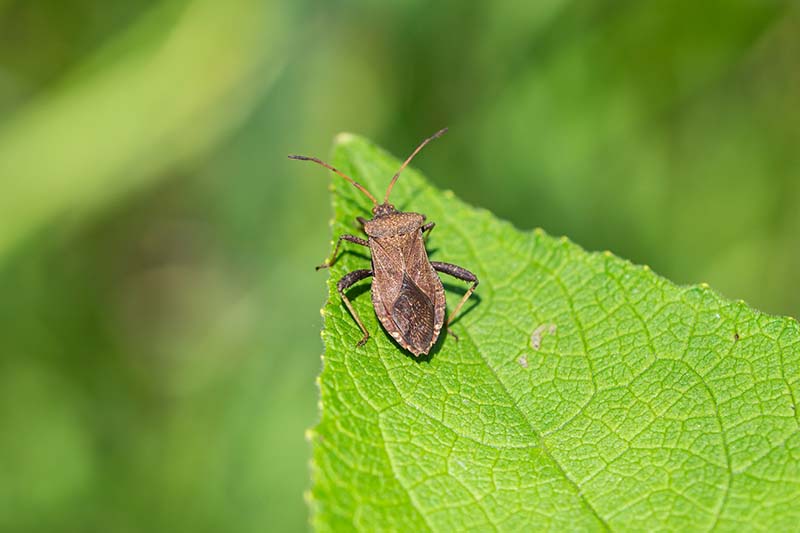

Their eggs are bronze-colored and football shaped, and these are deposited on the undersides of leaves in groups.
While larger, well-established plants may be able to resist an infestation, seedlings and plants that are in flower are more vulnerable. In the wake of a feeding frenzy, they may wilt and then die.
More common earlier in the growing season, the adults usually start showing up in gardens in early June, to feed and mate.
Once your plants start to wilt, the adults have already done their worst, and they can be hard to kill.
Row covers can help to keep the pests out, but be sure to remove them in time for pollination.
Insecticide treatments may be used to get rid of them, applied early in the morning or late at night to avoid interfering with the activity of beneficial pollinators.
Be sure to spray under leaves as well, because this is where the pests like to congregate.
Organic insecticidal soap may be applied to control squash bugs. You can also place a board in the garden nearby, as a trap. Remember to flip it over frequently, and kill any pests that you find hiding underneath.
Synthetic pyrethroids may also be used to eradicate these pests. Spray seedlings early in the season, as soon as squash bugs emerge. As an added bonus, these chemicals can help to control cucumber beetles as well.
Be sure to heed local regulations regarding the use of chemical insecticides, use them sparingly, and follow all package instructions closely.
These insects can overwinter in plant debris, so be sure to keep the garden clean during the season, and clean it up properly after the harvest as well. Wooden board traps should also be removed from the garden in the fall.
As a preventive measure, grow resistant varieties, and provide good care. Healthy plants are much more likely to survive an infestation than weak or stressed ones.
Learn more about how to control squash bugs here.
11. Squash Vine Borers
A moth in its adult stage, squash vine borer larvae love to feed on pumpkin stems, boring holes in them, and weakening your plants. This can cause them to wilt quickly.
Common in the eastern US, adults emerge in early to midsummer and lay their eggs at the base of plants.
The moths have a distinctive appearance, half an inch long with gray to black bodies that have orange and black markings, and clear to transparent green wings.
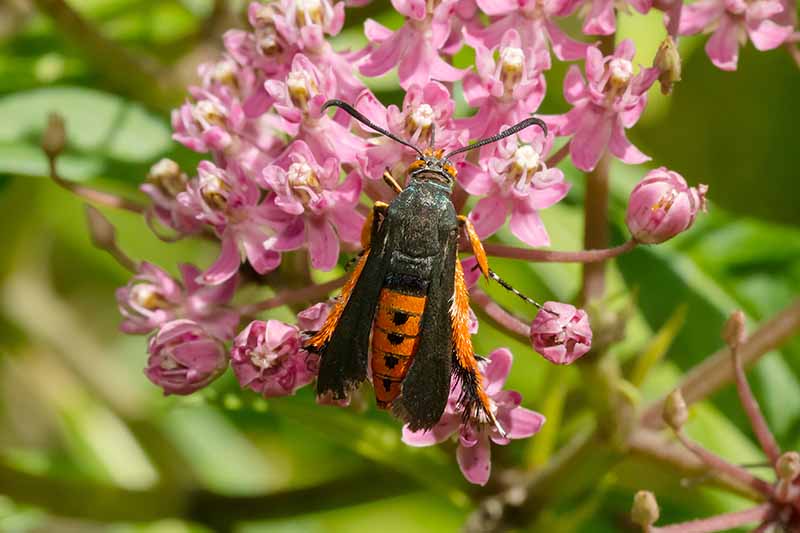

When the larvae hatch one or two weeks later, they start to feed. These can grow to be about an inch long, and they are white and wrinkled, with brown heads.
If you monitor them closely, you may be able to prevent a problem before it starts, or save your plants in the case of a minor infestation. Row covers can also help to keep them out, as long as the eggs or larvae aren’t already there.
Squash vine borers will target various types of squash and gourds. But ‘Hubbard’ squash is one of their favorite meals, so these can be planted as a trap crop. Parasitic wasps can provide biological control.
Diatomaceous earth can be applied preventively around the base of plants, to kill emerging larvae. And some gardeners swear by using wood ashes against these pests.
If you notice holes in your vines, you can perform a little surgery. Cut a small slit at the point of entry with a clean, sharp knife. Dig the larva out, dispose of it, and cover the wound in the stem with soil.
With proper care, the plant should heal at the entry point, and put out new roots where it’s been buried.
If you opt to use pesticides, timing is crucial, and they’ll only be effective if applied just when the eggs are hatching.
Bacillus thuringiensis subsp. kurstaki is a natural option, and chemical insecticides containing carbaryl or permethrin can be effective as well. Again, proceed with caution if you opt for chemical controls.
The best way to deal with these pests is preventively. Keep an eye out for flat, brown, oval-shaped eggs laid individually or in small groups around the crown.
After they hatch, inspect your plants for holes at the base, and yellowish frass that resembles sawdust.
Squash vine borers pupate in the soil, so be sure to rotate your crops, till the soil after the harvest and before planting time next spring, and clean up all plant debris at the end of the season.
Prevention Is Your Best Bet
Knowledge of the various factors, pests, and pathogens that may cause your pumpkin plants to droop will give you a fighting chance of saving your crop if wilting becomes an issue.
Take preventive measures to prevent infection and pest infestation, and follow proper care procedures to keep your pumpkins as healthy as possible.
Check your plants every few days to make sure they are not wilting from too little or too much water, or showing signs of disease. And also monitor for cucumber beetles, squash vine borers, and squash bugs.
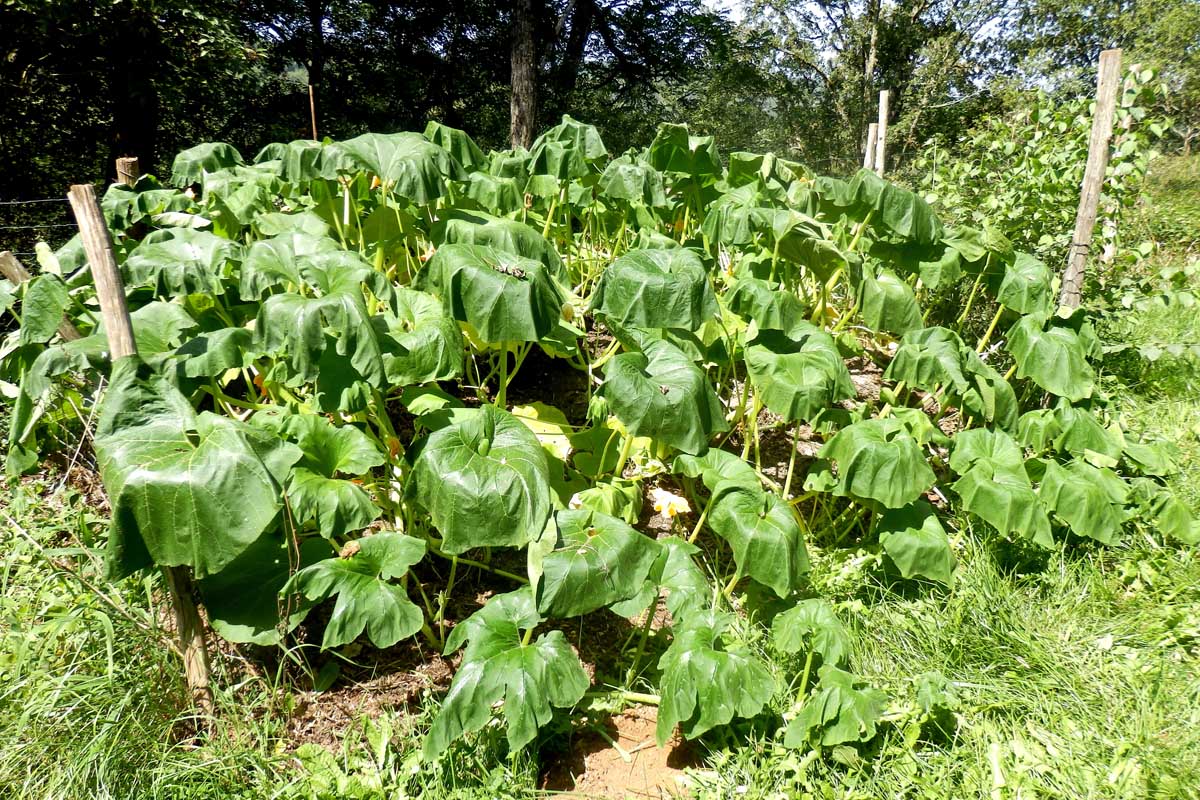

Purge any infected plants ASAP, to keep the pathogens from spreading throughout your pumpkin patch.
Our hope is that with these tips, you will succeed at growing giant pumpkins! (Or little ones, if that’s what you prefer).
Have you struggled with wilting pumpkin plants? Have an issue that you’re trying to diagnose? If so, let us know in the comments!
And for more information about growing pumpkins in your garden, check out these guides next:
[ad_2]
Source link

